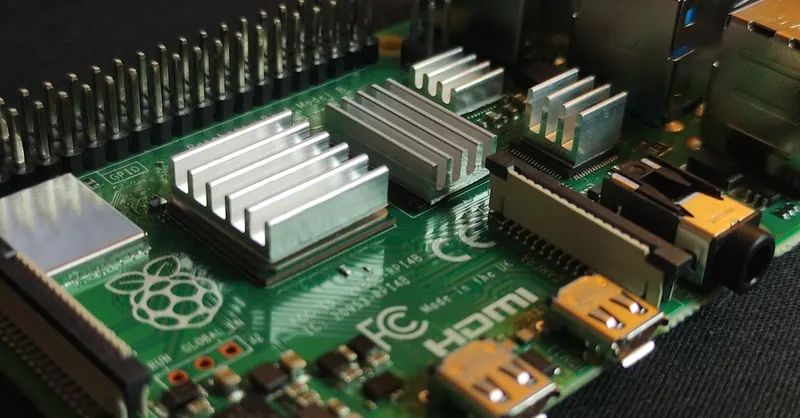Top Python MQTT Projects for Raspberry Pi Enthusiasts
Category: Embedded Systems
Dive Into Python MQTT Projects on Raspberry Pi
If you're a tech enthusiast, hobbyist, or developer intrigued by Raspberry Pi and embedded systems, you've likely encountered MQTT — a lightweight messaging protocol designed for IoT and microcontroller projects. Tackling Python MQTT projects can feel daunting when you’re searching for clear guidance, practical implementations, and scalable ideas. Whether you’ve dabbled with Raspberry Pi before or you are leveling up your programming skills in Python and C/C++, this post is crafted for you.
You’ve landed here because you want to turn your Raspberry Pi into an efficient, communicative device using MQTT, but finding well-structured projects and explanations tailored to your development skills can be challenging. Many tutorials are either too simplistic or overly technical without clear project roadmaps. This article offers an expertly designed outline covering practical Python MQTT projects on Raspberry Pi, explaining key concepts, protocols, setting up brokers, coding examples, and integrating sensors and actuators for real-world applications.
Unlike generic guides, this post is structured to walk you through progressively complex projects that build your confidence, offer reusable code snippets, and inspire you to innovate in home automation, data monitoring, and embedded system communication. Read on to unlock powerful projects that perfectly blend Python programming, MQTT, and Raspberry Pi hardware for your next creative venture.
- Dive Into Python MQTT Projects on Raspberry Pi
- Understanding MQTT and Its Role in Raspberry Pi Projects
- Setting Up Your Raspberry Pi Environment for Python MQTT
- Installing and Configuring an MQTT Broker on Raspberry Pi
- Building Your First Python MQTT Publisher and Subscriber on Raspberry Pi
- Integrating Sensors with Raspberry Pi Using MQTT and Python
- Creating Real-Time Data Dashboards with MQTT Data
- Automating Home or Device Control via MQTT Messages
- Securing MQTT Communications on Raspberry Pi
- Advanced MQTT Patterns and Multi-Device Communication on Raspberry Pi
- Troubleshooting and Optimizing Python MQTT Projects on Raspberry Pi
Understanding MQTT and Its Role in Raspberry Pi Projects
MQTT (Message Queuing Telemetry Transport) is a lightweight, publish-subscribe network protocol that is specifically designed for constrained devices and low-bandwidth, high-latency, or unreliable networks — making it an ideal fit for Raspberry Pi and embedded systems projects. At its core, MQTT enables devices to exchange messages efficiently and asynchronously, facilitating robust communication in Internet of Things (IoT) environments.
Why MQTT Suits Raspberry Pi and Embedded Systems
- Minimal Bandwidth Usage: MQTT’s compact message headers and payload encoding keep network traffic low, which is perfect for Raspberry Pi setups with limited connectivity or mobile data constraints.
- Low Power Consumption: The protocol’s low overhead helps preserve power, an essential factor for battery-powered or energy-sensitive embedded devices.
- Decoupled Communication: By employing a broker-based publish-subscribe pattern, devices don’t need direct knowledge of each other, improving system scalability and modularity.
- Reliability with Quality of Service (QoS): MQTT supports different QoS levels, ensuring messages are delivered reliably according to application needs — crucial for mission-critical sensor data in embedded projects.
- Cross-Platform and Language Support: MQTT clients exist for Python, C/C++, and many other languages, enabling seamless integration with diverse Raspberry Pi software stacks.
Typical Use Cases of MQTT in Raspberry Pi Projects
- Home Automation: MQTT facilitates real-time control and monitoring of smart home components such as lights, thermostats, and security cameras connected via Raspberry Pi hubs.
- Environmental Monitoring: Collecting sensor data like temperature, humidity, and air quality, then transmitting it efficiently to cloud services or local dashboards.
- Industrial IoT: Raspberry Pi-based edge devices can use MQTT to report machine status, anomalies, or maintenance alerts in factory automation systems.
- Remote Data Logging: MQTT allows Raspberry Pi units to publish sensor readings or system logs from remote locations to centralized servers for analysis.
- Wearables and Health Devices: Lightweight communication between embedded health sensors and monitoring apps can be maintained with minimal latency and power use.
By understanding the fundamentals and advantages of MQTT, you can better appreciate why it has become the go-to protocol for Raspberry Pi projects in the expanding world of IoT and embedded systems development. In the next sections, we will dive deeper into setting up MQTT brokers on Raspberry Pi and crafting Python scripts to harness its full potential.

Image courtesy of Craig Dennis
Setting Up Your Raspberry Pi Environment for Python MQTT
Before diving into your Python MQTT projects on Raspberry Pi, it's crucial to establish a robust development environment that ensures smooth implementation and optimal performance. This setup involves configuring the Raspberry Pi’s operating system, preparing the Python programming environment, and installing essential MQTT libraries like Paho MQTT, which is the de facto Python client for MQTT communication.
Prepare Your Raspberry Pi with Raspbian OS
-
Install Raspbian (Raspberry Pi OS):
To leverage the full potential of your Raspberry Pi, start by installing the latest version of Raspbian, the official Raspberry Pi operating system. Opt for the Raspberry Pi OS Lite if you prefer a lightweight, command-line focused environment, or the full desktop version for GUI-based development. You can download it from the official Raspberry Pi website. -
Update and Upgrade Your System Packages: After flashing and booting your Pi, keep your system up-to-date by running:
bash sudo apt update && sudo apt upgrade -yThis step ensures you have the latest security patches and package versions critical for MQTT and Python libraries compatibility.
Set Up a Python Environment for MQTT Development
Python serves as an ideal language for MQTT projects on Raspberry Pi due to its readability, vast ecosystem, and excellent MQTT client libraries.
-
Install Python 3:
Raspbian comes pre-installed with Python 3, but verify the version by:bash python3 --versionUpgrade if necessary to ensure compatibility with the latest MQTT libraries. -
Create a Virtual Environment (Recommended):
Isolate your MQTT project dependencies by creating a virtual environment:bash sudo apt install python3-venv python3 -m venv mqtt-env source mqtt-env/bin/activateThis setup prevents conflicts between different projects and keeps your system Python clean.
Install the Paho MQTT Library and Dependencies
The Paho MQTT Python client is widely recognized for its reliability and ease of use in IoT projects.
-
Upgrade pip to the latest version:
bash pip install --upgrade pip -
Install Paho MQTT:
bash pip install paho-mqtt -
Verify Installation: Test the installation quickly by running a Python interactive shell:
python import paho.mqtt.client as mqtt print(mqtt.__version__)A version number output confirms that the library is installed correctly.
Additional Tools to Enhance Your MQTT Development
- Mosquitto MQTT Broker:
Though this is not mandatory at this stage, installing the Mosquitto broker locally on your Raspberry Pi is highly recommended. It allows you to test MQTT publish and subscribe mechanisms locally before deploying applications.bash sudo apt install mosquitto mosquitto-clients sudo systemctl enable mosquitto sudo systemctl start mosquitto - Network Configuration:
Ensure your Raspberry Pi is connected to a stable Wi-Fi or Ethernet network with proper firewall settings to allow MQTT traffic on default port 1883.
By meticulously setting up your Raspberry Pi environment with these steps, you lay a strong foundation for developing and scaling Python MQTT projects. The combination of a clean Raspbian install, isolated Python environments, and reliable MQTT libraries like Paho equips you to build secure, efficient, and maintainable embedded communication systems. Next, we will explore configuring your MQTT broker and writing your first Python MQTT client scripts.

Image courtesy of Christina Morillo
Installing and Configuring an MQTT Broker on Raspberry Pi
To fully harness the power of MQTT in your Raspberry Pi projects, it’s essential to install and configure a reliable MQTT broker — the intermediary that manages message routing between publishing and subscribing clients. The most popular choice for Raspberry Pi and embedded systems is the Mosquitto MQTT broker, known for its lightweight footprint, ease of installation, and robust performance.
Installing Mosquitto Broker on Raspberry Pi
- Update Package Repositories:
Begin by ensuring your Raspberry Pi’s package list is current:bash sudo apt update - Install Mosquitto and Client Utilities:
Use the following command to install both the broker and the command-line client tools needed for testing:bash sudo apt install -y mosquitto mosquitto-clients - Enable Mosquitto to Start on Boot:
To make sure your broker runs automatically every time your Raspberry Pi is powered on:bash sudo systemctl enable mosquitto sudo systemctl start mosquitto
Basic Mosquitto Configuration
By default, Mosquitto starts with a basic configuration that permits anonymous connections on port 1883. For local development, this is sufficient, but it’s best practice to customize settings for reliability and security.
-
Configuration File Location:
The main configuration file resides at/etc/mosquitto/mosquitto.conf. You can keep the default or create your own config in/etc/mosquitto/conf.d/for modular setups. -
Common Configuration Adjustments:
- Define Listener Port: To specify the MQTT port (default is 1883).
- Disable Anonymous Access: Enhance security by requiring client authentication.
- Set Logging Levels: For debugging and monitoring broker activity.
Example snippet to force authenticated access on port 1883:
listener 1883
allow_anonymous false
password_file /etc/mosquitto/passwd
Testing Mosquitto Broker Connectivity
Mosquitto clients installed alongside the broker allow you to quickly verify operational status.
-
Open Two Terminal Windows on Raspberry Pi.
-
Start a Subscriber:
Subscribe to a test topic namedtest/topicwith:bash mosquitto_sub -h localhost -t test/topic - Publish a Test Message:
From the other terminal, send a message:bash mosquitto_pub -h localhost -t test/topic -m "Hello MQTT" - Confirm Reception:
The message should appear in the subscriber’s terminal, verifying successful broker communication.
MQTT Broker Security Basics
Securing your Mosquitto broker is critical, especially if you expose it over a network.
- User Authentication:
Create password files withmosquitto_passwdto require username/password credentials.
Example to create a user:
bash
sudo mosquitto_passwd -c /etc/mosquitto/passwd username
Then restart Mosquitto to apply changes.
-
TLS Encryption:
For encrypted communication, generate SSL certificates and configure Mosquitto to use TLS, ensuring data privacy and protection from interception. -
Firewall and Network Settings:
Restrict open ports to limit unauthorized access. Use tools likeufwto control inbound traffic to port 1883 (or your custom port).
By carefully installing, configuring, and securing your Mosquitto MQTT broker on Raspberry Pi, you establish a robust backbone for your Python MQTT projects. This foundation guarantees efficient message handling, scalability, and secure communication across your IoT and embedded systems ecosystem. In the upcoming section, we will guide you through creating Python clients to publish and subscribe to MQTT topics, leveraging the broker you’ve just set up.

Image courtesy of Cup of Couple
Building Your First Python MQTT Publisher and Subscriber on Raspberry Pi
With your Mosquitto MQTT broker installed and running smoothly on your Raspberry Pi, it’s time to dive into writing your initial Python MQTT clients. These scripts will form the foundational blocks for most MQTT-enabled Raspberry Pi projects, allowing your device to publish sensor data, receive commands, or exchange information with other IoT components seamlessly.
Writing a Simple MQTT Publisher in Python
The publisher client sends messages to a specific MQTT topic on the broker. Here’s a minimal Python script that publishes messages to the topic home/room1/temperature. This example assumes you’ve already installed the Paho MQTT library (paho-mqtt) as covered in previous sections.
import paho.mqtt.client as mqtt
import time
# MQTT broker details
broker_address = "localhost" # Use your broker IP if remote
topic = "home/room1/temperature"
# Create a new MQTT client instance
client = mqtt.Client("Publisher1")
# Connect to the MQTT broker
client.connect(broker_address)
# Publish temperature data every 5 seconds
try:
while True:
temperature = 22.5 # Replace with sensor data retrieval logic
client.publish(topic, temperature)
print(f"Published {temperature}°C to topic '{topic}'")
time.sleep(5)
except KeyboardInterrupt:
print("Publisher stopped")
Key points:
- The
mqtt.Client()instance creates a new client identified by"Publisher1". - The
connect()method establishes a connection to the local Mosquitto broker. - The
publish()method sends a message payload (temperature) to the specified topic. - The loop simulates continuous data publishing; in practical applications, replace the static value with actual sensor inputs.
Creating a Python MQTT Subscriber Script
The subscriber client listens for published messages on a topic and processes incoming data. Below is a corresponding Python script that subscribes to the home/room1/temperature topic and prints received messages in real-time.
import paho.mqtt.client as mqtt
# MQTT broker details
broker_address = "localhost"
topic = "home/room1/temperature"
# Define callback for received messages
def on_message(client, userdata, message):
payload = message.payload.decode()
print(f"Received message '{payload}' on topic '{message.topic}'")
# Create a new MQTT client instance
client = mqtt.Client("Subscriber1")
# Bind the on_message callback
client.on_message = on_message
# Connect to the MQTT broker
client.connect(broker_address)
# Subscribe to the topic
client.subscribe(topic)
# Start the MQTT client loop to listen for messages
client.loop_forever()
Highlights:
- The
on_messagecallback is triggered every time a new message is received, ensuring your subscriber reacts instantly. - Using
client.loop_forever()keeps the subscriber listening indefinitely. - Decoding the message payload converts the raw byte stream into a readable string.
Running Your Publisher and Subscriber
- Open two terminal windows on your Raspberry Pi.
- Start the subscriber script first to begin listening to the topic.
- Run the publisher script in the second terminal to start sending messages.
- Observe the subscriber terminal receiving and displaying the temperature data every few seconds.
This basic publisher-subscriber pair demonstrates the power and simplicity of MQTT communication over Python on Raspberry Pi. From here, you can expand these scripts to integrate real sensor data, implement message acknowledgments, or add authentication and QoS levels for improved reliability. By mastering these core examples, you’re set to develop sophisticated MQTT-based IoT systems that unlock the full potential of your Raspberry Pi projects.

Image courtesy of Christina Morillo
Integrating Sensors with Raspberry Pi Using MQTT and Python
One of the most impactful applications of Python MQTT projects on Raspberry Pi is integrating real-world sensors to gather environmental or motion data and then efficiently transmitting this data through MQTT messaging. Leveraging sensors such as temperature, humidity, or motion sensors allows your Raspberry Pi to become a dynamic IoT node, capable of feeding continuous streams of valuable information to an MQTT broker for processing, logging, or triggering automated responses.
Real-World Sensor Integration Examples
- Temperature and Humidity Sensors: Devices like the DHT11 or DHT22 are widely used due to their affordability and ease of interfacing via Raspberry Pi GPIO pins. Using Python libraries like
Adafruit_DHT, you can periodically read sensor values and publish them to MQTT topics such assensors/temperatureandsensors/humidity. - Motion Sensors: Passive Infrared (PIR) sensors detect human presence or movement, making them ideal for security or occupancy monitoring projects. Python scripts can listen for motion events and publish notifications to topics like
home/motion/detected. - Environmental and Light Sensors: Sensors like the BH1750 or LDR (Light Dependent Resistor) can provide luminosity data for smart lighting systems that react to ambient conditions through MQTT message exchanges.
Key Advantages of Using MQTT with Sensors on Raspberry Pi
- Asynchronous Data Publishing: Sensors can publish data at configurable intervals or event-triggered instances without blocking other program operations, thanks to MQTT’s publish-subscribe architecture.
- Decoupled Communication: Sensor nodes don’t require knowledge of subscribers, enabling scalable distributed systems where multiple devices or cloud services can consume sensor data independently.
- Efficient Bandwidth Usage: MQTT’s lightweight messaging reduces overhead, making sensor data transmission well-suited for constrained network environments typical in embedded and remote deployments.
- Flexible Data Processing: Sensor data published to MQTT topics can be subscribed to by diverse clients — from local dashboard apps to cloud-based analytics platforms — for real-time monitoring or elaborate data aggregation.
Practical Python MQTT Sensor Workflow on Raspberry Pi
- Interface Sensor Hardware: Connect your sensor module to the Raspberry Pi GPIO pins or I2C/SPI bus as required.
- Read Sensor Data in Python: Utilize sensor-specific Python libraries or custom GPIO code to capture data samples.
- Publish Sensor Data via MQTT: Format sensor readings as payloads (e.g., JSON strings or plain text) and publish them to relevant MQTT topics using the Paho MQTT client.
- Subscribe and Process Data Elsewhere: Other MQTT clients — possibly running on other Pis, PCs, or cloud servers — subscribe to these topics to analyze, alert, or log sensor data.
By seamlessly combining sensor integration, Python programming, and MQTT messaging on your Raspberry Pi, you unlock countless possibilities for building responsive, scalable, and low-latency IoT sensor networks tailored for home automation, environmental monitoring, or security applications. This approach not only optimizes resource usage but also simplifies maintenance and expansion of distributed sensor systems.

Image courtesy of Mathias Wouters
Creating Real-Time Data Dashboards with MQTT Data
Visualizing sensor data collected via MQTT topics is essential for gaining actionable insights and monitoring your Raspberry Pi projects effectively. Utilizing Python frameworks or third-party visualization tools like Grafana can transform raw MQTT messages into dynamic, real-time dashboards that display environmental parameters, system status, or any IoT data stream in an intuitive format.
Visualizing MQTT Data with Python
Python offers multiple libraries to build custom dashboards that subscribe to MQTT topics and render live sensor data:
- Dash by Plotly: A powerful web application framework ideal for creating interactive dashboards. You can use Paho MQTT within the Dash callback functions to update graphs or textual indicators in real time based on MQTT messages.
- Matplotlib and Tkinter: For desktop-based applications, combining Matplotlib’s plotting capabilities with Tkinter GUI enables you to build lightweight visualizations that refresh live as new MQTT data arrives.
- Bokeh: Another popular choice for browser-based interactive plots, Bokeh can be integrated with MQTT clients to reflect sensor updates dynamically.
These Python frameworks allow extensive customization, from simple line charts tracking temperature trends to complex multi-sensor visualizations aggregating diverse data on a single display. Implementing MQTT subscriptions within these environments ensures your dashboard reflects fresh data continuously without polling overhead.
Leveraging Grafana for Professional MQTT Data Dashboards
Grafana is a versatile, open-source visualization platform widely used in IoT and industrial monitoring due to its rich plugin ecosystem and ease of integration with time-series databases.
To use Grafana for MQTT data visualization, follow these key steps:
-
Set Up a Time-Series Database:
Since Grafana does not natively support MQTT, you need to store incoming MQTT messages in a database optimized for time-series data — popular options include InfluxDB, Prometheus, or TimescaleDB. -
Bridge MQTT Messages to the Database:
Use lightweight MQTT-to-database bridge scripts or existing tools like Telegraf with MQTT input plugin to ingest and store your sensor data. These tools subscribe to your MQTT topics and write timestamped entries into the database. -
Connect Grafana to Your Database:
Add the configured time-series database as a data source in Grafana. This enables you to build flexible dashboards with panels showing graphs, gauges, heatmaps, and alert rules based on historical and live data. -
Design Custom Dashboards:
Grafana’s drag-and-drop interface lets you create dashboards tailored to your project needs, such as temperature monitoring in various rooms, humidity trends, or motion detection timelines from your Raspberry Pi MQTT sensor network.
Benefits of Real-Time MQTT Visualization for Raspberry Pi Projects
- Immediate Insights: Dashboards provide live updates on sensor states and system metrics, crucial for timely interventions and automated control.
- Data-Driven Decisions: Visualization aids in identifying patterns, anomalies, or long-term trends, improving system reliability and user experience.
- Centralized Monitoring: Multiple Raspberry Pis or embedded devices publishing MQTT data can be aggregated into unified dashboards, making large-scale IoT management straightforward.
- Alerting and Automation: Integration with Grafana’s notification channels allows triggering alarms on threshold breaches, enabling proactive system responses.
By incorporating real-time visualization of MQTT data, your Raspberry Pi projects transcend raw data collection and evolve into intelligent, user-friendly IoT systems. Whether you choose Python-based dashboards or leverage powerful platforms like Grafana, visually monitoring your MQTT sensor streams empowers smarter development and operational excellence.

Image courtesy of Atlantic Ambience
Automating Home or Device Control via MQTT Messages
Transform your Raspberry Pi into a smart home automation hub by leveraging MQTT to control actuators like LEDs, relays, or motors with commands sent from Python scripts or mobile applications. Using MQTT messages to trigger actuators allows you to implement real-time, responsive control systems that are scalable, flexible, and network-efficient.
Controlling Actuators with MQTT and Python on Raspberry Pi
Actuators such as LEDs and relays can be wired directly to Raspberry Pi’s GPIO pins and controlled remotely via MQTT messages. Here’s how this integration typically works:
-
Subscribe to Control Topics:
Write Python MQTT subscriber scripts on Raspberry Pi that listen for specific command messages on topics likehome/livingroom/lightordevice/relay1/control. -
Parse Received Commands:
When a control message arrives (e.g., "ON", "OFF", or brightness levels), the Python script interprets the payload and actuates the corresponding GPIO pins. -
Trigger GPIO Outputs:
Using libraries likeRPi.GPIOorgpiozero, your script toggles LEDs, switches relays, or drives motors precisely as instructed, activating connected devices instantly. -
Provide Feedback or Status Updates:
For robust automation, your Python clients can publish status messages back through MQTT topics to confirm actions or report device states, enabling seamless two-way communication.
Benefits of Automating Devices via MQTT Messaging
- Wireless and Decoupled Control: Devices do not require direct physical connections or knowledge of controllers, allowing flexible mobile apps, web dashboards, or other Pis to send commands effortlessly.
- Scalability: Adding more actuated devices only requires subscribing to additional MQTT topics with minimal changes to the Python control logic.
- Low Latency and Efficient Network Use: MQTT’s lightweight protocol transmits short control messages instantaneously over local or internet networks.
- Cross-Platform Compatibility: Mobile apps using MQTT clients (e.g., MQTT Dash, IoT MQTT Panel) can easily send commands without proprietary software or complex setup.
- Customization and Expandability: Complex automation rules, such as conditional triggers or schedules, can be implemented in Python scripts subscribed to various MQTT topics, streamlining integration with sensors or external triggers.
By implementing MQTT-based control of actuators on your Raspberry Pi using Python, you open the door to endless possibilities of home automation, remote device management, and embedded system control. This method is especially suited for smart lighting, HVAC systems, security alarms, irrigation controls, and robotics projects where precise and reliable device actuation is essential. In following sections, we’ll provide practical Python code examples demonstrating actuator control logic and MQTT command parsing to get your IoT automation live quickly.

Image courtesy of Jakub Zerdzicki
Securing MQTT Communications on Raspberry Pi
When deploying MQTT projects on your Raspberry Pi—especially in home automation, industrial IoT, or remote sensing applications—securing MQTT communications is paramount to protect data integrity, privacy, and prevent unauthorized access. By implementing best practices such as authentication, encryption via TLS, and hardening both broker and client configurations, you can significantly increase the robustness of your embedded MQTT ecosystem.
Best Practices for MQTT Authentication
-
Enable Username and Password Authentication:
Avoid running your Mosquitto broker with anonymous access enabled. Configure the broker to require users to authenticate by creating a password file usingmosquitto_passwd:bash sudo mosquitto_passwd -c /etc/mosquitto/passwd yourusernameUpdate your Mosquitto configuration to enforce authentication:allow_anonymous false password_file /etc/mosquitto/passwdUsing credentials ensures that only authorized Python MQTT clients can publish or subscribe to topics on your broker. -
Use Unique Client IDs and Credentials:
When creating Python MQTT clients, generate distinctclient_ids and manage credentials securely. Avoid hardcoding sensitive information directly in scripts; instead, use environment variables or secure configuration files with restricted permissions. -
Implement Access Control Lists (ACLs):
Fine-tune topic-level access control by specifying which users can read or write to particular topics via an ACL file. This minimizes potential damage if a client is compromised by restricting its interaction scope.
Enabling MQTT Encryption with TLS/SSL on Raspberry Pi
Securing MQTT traffic with Transport Layer Security (TLS) encrypts data exchanged between clients and the broker, preventing eavesdropping and man-in-the-middle attacks.
-
Generate SSL/TLS Certificates:
Create a certificate authority (CA), server certificate, and private key. Alternatively, leverage existing certificates if available. -
Configure Mosquitto for TLS:
Update the broker configuration to listen on the secure MQTT port (default 8883) and specify paths to your certificate files:listener 8883 cafile /etc/mosquitto/certs/ca.crt certfile /etc/mosquitto/certs/server.crt keyfile /etc/mosquitto/certs/server.key require_certificate falseRestart the Mosquitto service after changes. -
Modify Python MQTT Clients to Use TLS:
In your Python scripts, configure the Paho client to use TLS and verify the broker's identity:python client.tls_set(ca_certs="/path/to/ca.crt") client.tls_insecure_set(False)This setup encrypts all MQTT messages, safeguarding your data especially when transmitting over public or untrusted networks.
Securing Broker and Client Applications
-
Run the Mosquitto Broker Under a Dedicated User:
Limit permissions by running the broker service with a non-root user account to reduce risk surface. -
Keep Software Updated:
Regularly update the Raspberry Pi OS, Mosquitto broker, and Python MQTT libraries to patch known vulnerabilities. -
Limit Open Ports and Network Exposure:
Use firewall rules (e.g.,ufw) to restrict MQTT ports (1883 for plaintext and 8883 for TLS) and only allow trusted IP addresses where feasible. -
Validate and Sanitize MQTT Messages in Applications:
On the client side, implement proper error handling and input validation for incoming message payloads to avoid injection attacks or corrupted data processing.
By integrating these comprehensive authentication, TLS encryption, and application hardening techniques, you ensure that your MQTT communications on Raspberry Pi are secure, reliable, and resilient against common network threats. Prioritizing security in your IoT projects is essential to protect both your devices and sensitive data, laying a trustworthy foundation for scalable, production-grade distributed systems.

Image courtesy of Pixabay
Advanced MQTT Patterns and Multi-Device Communication on Raspberry Pi
As your Python MQTT projects on Raspberry Pi grow in complexity, implementing advanced MQTT patterns and orchestrating communication across multiple devices becomes essential to building scalable, resilient IoT systems. Leveraging features such as MQTT bridging, retained messages, and the Last Will and Testament (LWT) mechanism can drastically improve system reliability, facilitate fault tolerance, and enhance message delivery guarantees in multi-Raspberry Pi deployments.
MQTT Bridging for Multi-Broker and Multi-Device Networks
MQTT bridging allows two or more MQTT brokers, potentially distributed across various Raspberry Pis or even remote locations, to interconnect and share messages seamlessly as if part of a single MQTT fabric. This pattern is invaluable when building large-scale IoT architectures requiring:
- Distributed Processing: Offload local data processing on edge Raspberry Pis while syncing critical information back to a centralized broker.
- Network Segmentation: Isolate device clusters geographically or functionally without losing the ability to exchange MQTT messages.
- Resiliency: Enable redundancy and failover by forwarding messages through alternative brokers when one node becomes unavailable.
Configuring Mosquitto brokers for bridging involves specifying remote broker connections and mapping topics to forward, effectively propagating MQTT messages across your Raspberry Pi network.
Retained Messages for State Persistence
Retained messages are MQTT packets stored on the broker to keep the last known good state on a topic. When a new MQTT client subscribes to that topic, the broker immediately sends the retained message, ensuring devices have immediate access to the current state without waiting for the next publish event.
This pattern is especially useful for Raspberry Pi projects involving:
- Device status reporting: For example, publishing actuator states so new subscribers instantly know whether a light is ON or OFF.
- Configuration sharing: Persisting the last configuration or command sent to the system for consistent device behavior upon reconnection.
Using retained messages minimizes communication delays and improves system coherence in distributed MQTT ecosystems.
Last Will and Testament (LWT) for Robust Fault Detection
The Last Will and Testament feature is a built-in MQTT mechanism where a client registers a “will message” with the broker during connection. If this client disconnects unexpectedly (e.g., power loss or network failure), the broker automatically publishes the will message on the designated topic. This enables other MQTT clients to detect offline nodes and take appropriate recovery actions.
In Raspberry Pi multi-device MQTT setups, LWT can be used to:
- Detect sensor or actuator failures by monitoring their LWT topics.
- Trigger automated alerts or fallback procedures in home automation or industrial control systems.
- Maintain real-time awareness of device availability to coordinate multi-node task orchestration effectively.
Orchestrating Multiple Raspberry Pis with Python MQTT
Coordinating multiple Raspberry Pis communicating via MQTT requires designing thoughtful topic hierarchies, client IDs, and message flows. Consider:
- Hierarchical Topic Structures: Use descriptive, consistent topic namespaces such as
home/livingroom/sensor1/temperatureorfactory/line1/actuator3/statusto organize multi-device data and commands logically. - Unique Client Identifiers: Assign distinct client IDs to each Raspberry Pi or MQTT client to prevent connection conflicts and simplify device management.
- Message QoS Levels: Tailor Quality of Service based on message criticality; use higher QoS for commands and critical status updates to guarantee delivery, while less critical telemetry can use lower QoS for efficiency.
- Synchronization and State Sharing: Combine retained messages and LWT with periodic status updates to maintain synchronized states across devices and central systems.
By mastering these advanced MQTT features and multi-device orchestration strategies, you empower your Raspberry Pi projects to operate as reliable, scalable, and intelligent IoT networks. Whether deploying smart home clusters, sensor arrays, or industrial monitoring systems, embracing bridging, retained messages, and LWT will significantly enhance communication robustness and system awareness.

Image courtesy of Jakub Zerdzicki
Troubleshooting and Optimizing Python MQTT Projects on Raspberry Pi
Building robust Python MQTT applications on Raspberry Pi often involves addressing common challenges and fine-tuning performance for long-running deployments. Effective troubleshooting, debugging, and optimization strategies ensure your MQTT communications remain reliable, efficient, and maintainable over time — critical factors for scalable embedded systems and IoT projects.
Common MQTT Issues and Debugging Tips
- Connection Failures:
- Verify broker availability and correct IP/hostname settings.
- Ensure network ports (default 1883 or 8883 for TLS) are open and accessible by the Raspberry Pi client.
- Check MQTT client credentials if authentication is enabled on the broker.
-
Use Mosquitto command-line tools (
mosquitto_pubandmosquitto_sub) to isolate network or broker problems. -
Message Delivery Problems:
- Confirm matching topic subscriptions with correct topic filters.
- Use appropriate QoS levels:
- QoS 0 (At most once): Fast but no guarantees.
- QoS 1 (At least once): Delivered at least once, might have duplicates.
- QoS 2 (Exactly once): Most reliable but adds overhead.
-
Enable detailed logging on broker to analyze message flow and client behavior.
-
Unexpected Disconnections or Timeouts:
- Check for network stability issues or Wi-Fi signal weaknesses.
- Verify MQTT keep-alive settings in the Python client to maintain persistent connections.
-
Handle
on_disconnectoron_connect_failcallbacks to implement reconnection logic gracefully. -
Data Encoding and Payload Consistency:
- Consistently encode/decode message payloads (e.g., UTF-8 or JSON) to prevent parse errors.
- Validate incoming messages before processing to avoid crashes due to malformed data.
Performance Tuning for Long-Running MQTT Applications
-
Efficient Resource Usage:
Minimize CPU and memory overhead by optimizing Python scripts to avoid blocking calls and excessive loops. Utilize asynchronous MQTT clients or background threads where applicable. -
Keep-Alive Interval Configuration:
Adjust keep-alive intervals considering network conditions; too low intervals can trigger false disconnections, while too high delays detection of real issues. -
Message Rate Management:
Throttle publish rates for sensors or actuators to balance timely updates with network and broker capacity. Batch data encapsulation in single MQTT messages where feasible to reduce packet overhead. -
Connection Persistence:
Use persistent sessions (clean_session=False) for clients that disconnect periodically to maintain subscription and message state efficiently.
Maintenance Best Practices
-
Regular Software Updates:
Keep Raspberry Pi OS, Mosquitto broker, and Python MQTT libraries current to benefit from bug fixes and performance improvements. -
Comprehensive Logging and Monitoring:
Enable application and broker logs with adjustable verbosity to capture anomalies early and facilitate debugging. -
Backup Configuration and Credentials:
Securely store broker configurations, SSL certificates, and client credentials to enable quick restoration and prevent downtime. -
Plan for Scalability:
Architect topic hierarchies and client management strategies mindful of future expansion, avoiding overly flat or ambiguous MQTT namespaces.
By proactively addressing these troubleshooting scenarios and applying performance optimizations, your Python MQTT projects on Raspberry Pi will achieve greater stability, responsiveness, and scalability—delivering consistent results in demanding IoT and embedded system environments.

Image courtesy of Nemuel Sereti
